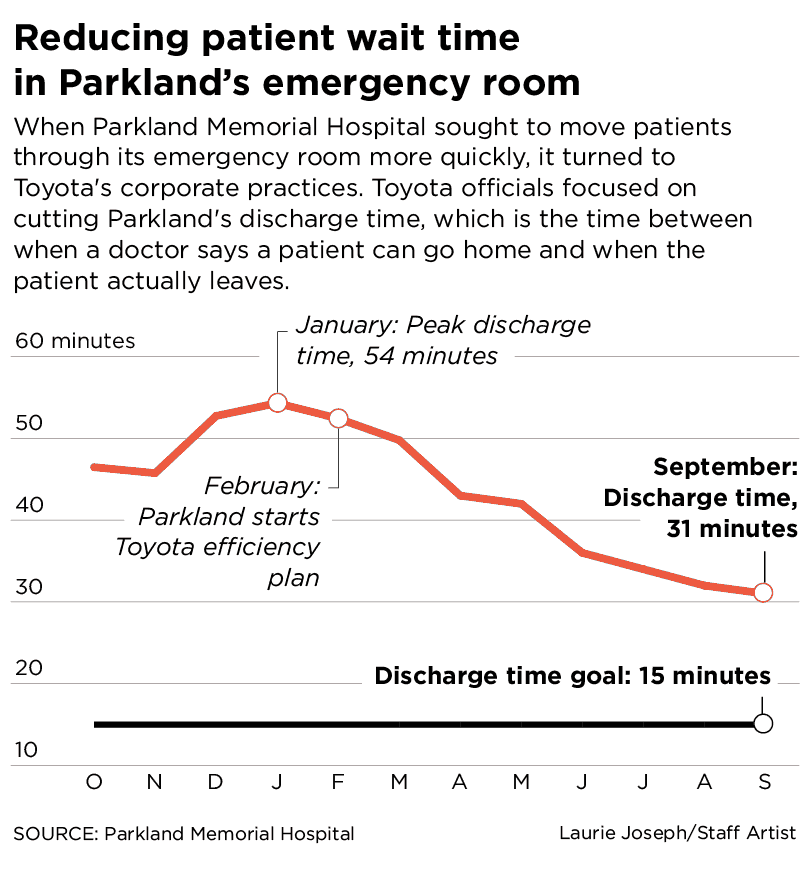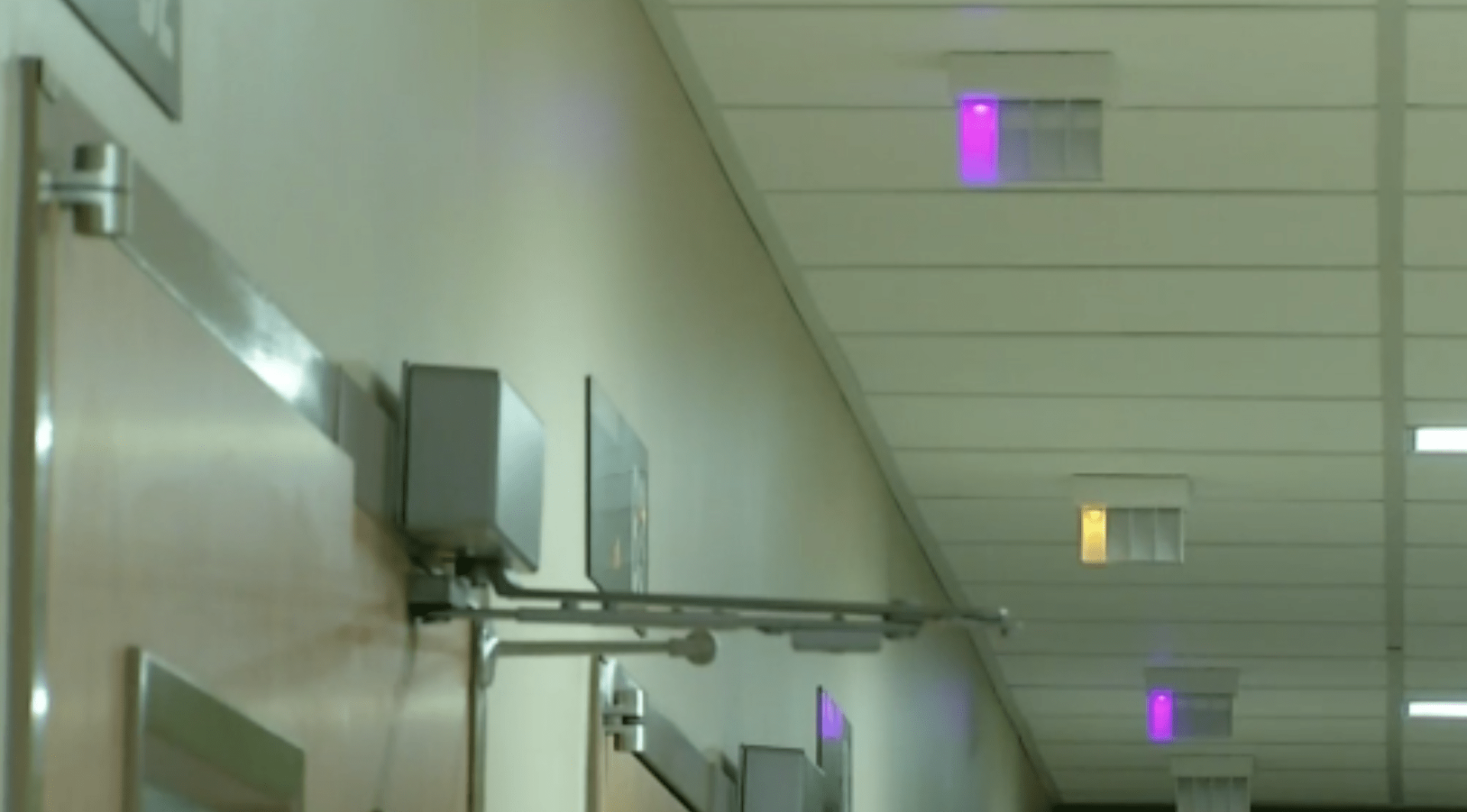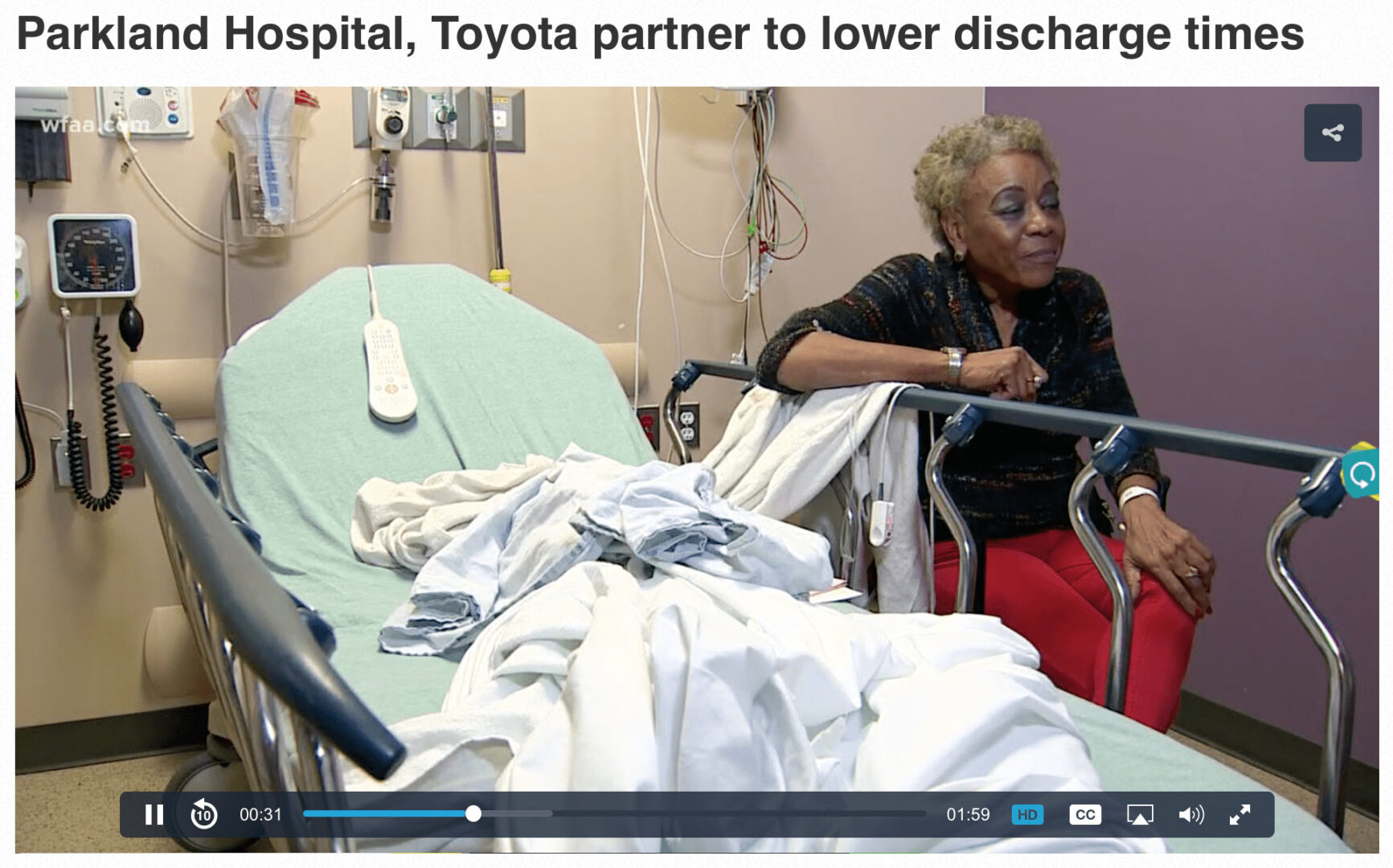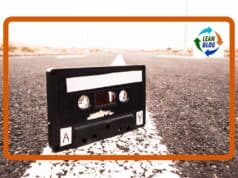I hope everybody in the U.S. had a nice Thanksgiving holiday. There's much to be thankful for, including Toyota's ongoing efforts to help organizations through their TSSC non-profit arm. See past posts that reference their work.
They recently helped reduce infections in the NICU at Children's Health, as I wrote about here:
Toyota Helps Children's Health Dallas Reduce Some CLABSI Infections 75%
Toyota's efforts at Parkland got a lot of coverage in the local DFW news. Keep in mind this is the “new Parkland” that opened in 2015, not the same building in which staff and doctors made an attempt at saving JFK's life in 1963. Today, it's one of the busiest emergency departments in the U.S. as the county hospital for Dallas County.
Here is the headline from the Dallas Morning News:
How Toyota improved Parkland Hospital's ER — with purple lights
I'll give credit to Dr. Fred Cerise, the CEO of Parkland Memorial Hospital, for reaching out to Toyota and TSSC for help.
…the company agreed to help on the condition that the project not be used as part of a layoff plan. That was no problem, Cerise said.
I'll give Toyota credit for insisting on the “no layoffs” commitment. When I worked for ValuMetrix Services, we set the same requirement with our clients – no layoffs due to Lean, or we wouldn't work with them. Dr. Cerise should get credit for agreeing. See my past article about how Lean is a great alternative to the typical healthcare layoffs and attempts at cost cutting.
Dr. Cerise was focused on creating capacity, not making any cuts:
“So this wasn't about downsizing the operation. This was about: How can we create more capacity and get more patients through?”
Toyota worked with Parkland for eight months… I wish they would have worked with the reporter on being a bit more clear with this unfortunate bit of language:
From the beginning, Toyota didn't want to apply its expertise in assembly-line efficiency to medicine, which could hurt patients.
For one, I wouldn't limit Toyota's expertise to “efficiency.” If you look at Toyota's own page about the Toyota Production System, you see it's about flow and quality.
Lean isn't just about “assembly lines,” either
Of course Toyota wouldn't want to do anything to hurt patients, as TPS and Lean are supposed to put safety and quality first.
Narrowing the Scope
In classic Toyota problem solving style (as I've learned from Pascal Dennis and others), they took a very broad, vague, challenging problem (patient flow through the emergency department) and narrowed it down a bit, to focus on the “discharge time.”
It seems the mindset is that it's better to solve one part of the problem, to improve one part of the value stream… as long as you're not sub optimizing things or pushing the waste and delays someplace else.
So the Toyota team decided to tackle one segment of the many hours that patients spend in the ER: the “discharge time.” That is, the time patients must wait between a doctor's discharge orders and the time they leave the hospital. If those minutes could be cut down, the bed would open up faster for a new patient, reducing wait times.
Staff were “skeptical.” I understand “skepticism” and I would normally expect it and welcome it, as long as that skepticism leads to two-way discussion and education, along with some small tests of change that can help prove that these methods help in healthcare.
One nurse went from skeptical to enthusiastic:
“This is really weird — they make cars, we help people,” said Stephanie Warnock, a nurse who worked on the project with Toyota. “But it was really cool to see how you can apply the same mechanics to anything. It opened our eyes to things on the floor that we needed to change.”
Yes, people are not cars. There's no arguing that. :-)
See my previous article about Lean helping in healthcare even when people aren't cars.
The article reports that the average discharge time fell from 52 minutes in February to 31 minutes in September. Better yet, the article provided a run chart for better context:

They think the 15-minute goal is achievable.
Looking at the chart, I still wish the newspaper called it something like the “Toyota improvement plan” or the “Toyota quality plan” instead of just the “Toyota efficiency plan.” Efficiency means nothing if safety or quality suffer, as I'm sure Toyota emphasized.
How Did They Do It?
The article has more details, but I'll summarize their approach as:
- Studying and breaking down how the work was being done
- Challenging the status quo method
- Engaging and empowering the people who do the work (while also bringing in an important “fresh eyes” perspective
- Standardizing how nurses worked with patients on the discharge work, helping prevent distraction, interruption, and delay
- Improving visibility to patient status, making it easier to manage flow
They had the IT department make some changes so lights outside patient rooms were easier to use:
One major change the team came up with was using a light system that had come with the brand-new hospital. Each patient has his or her own room, with a light on the ceiling outside. Previously, the ER team didn't use the lights because they involved a time-consuming code and didn't seem useful. The Toyota team got the hospital's information technology department to reconfigure the lights to be more applicable to the ER's needs.
The hospital had fancy technology. Instead of blaming staff for not using the technology, Toyota helped make it easier for people to do the right thing. I think that's a great example of TPS thinking that we'd hope to see in any “Lean” environment.
Principle 8 of the “The Toyota Way'” management system says:
Use only reliable, thoroughly tested technology that serves your people and processes.
Toyota often unfairly gets labeled as being anti-technology. No, they just want to make sure technology is helpful and hospitals aren't always good at doing that.
They also changed the process to ask the patient earlier in their stay if they would need help from a social worker, since waiting for a social worker had been one of the causes of discharge delay.
It's Not Just the Lights

Light systems like this are nothing new. It's a high-tech version of manual “flags” that you often see sticking out from the wall near the door of exam rooms in hospitals or outpatient clinics.
I can't tell you how many times I've seen systems like that NOT being used.
It's not just the technology that matters — it's also the workflows.
You see purple lights in that photo that means the room is empty and ready for a new patient. You also need to have staff who are ready for that patient. The purple light doesn't mean a patient magically gets back there. It takes a team working together in a system (and working to improve that system over time).
Other Media Coverage
Here is a video news story from the local NBC affiliate:
They described it as being about “the patient experience,” which is a better label than “efficiency.” Ah, then the reporter said, “Toyota knows a thing about efficiency.”
AND QUALITY!
Anyway, I'm thankful that Toyota is helping our local community.
You also hear a Texas-ism about a patient “fixin' to leave.” That means “is ready to leave.” :-)
Here is video from the local ABC station that includes some comments from a patient (her discharge time was 26 minutes):
If you listen to the patient, I don't know if she was commenting on their food, specifically, or was just repeating the common idea that hospital food is bad. An opportunity for improvement, with or without Toyota's continued help? :-)
What will happen next? The newspaper article makes reference to Parkland's internal Lean group. Will the E.D. sustain the gains? Will they be inspired and empowered to continue refining the discharge process? Will they work on other parts of the value stream and patient flow, more broadly?
What do you think? Please scroll down (or click) to post a comment. Or please share the post with your thoughts on LinkedIn – and follow me or connect with me there.
Did you like this post? Make sure you don't miss a post or podcast — Subscribe to get notified about posts via email daily or weekly.
Check out my latest book, The Mistakes That Make Us: Cultivating a Culture of Learning and Innovation:










Good stuff, Mark. Despite a couple media misses (assembly line?), good publicity for Lean in healthcare.